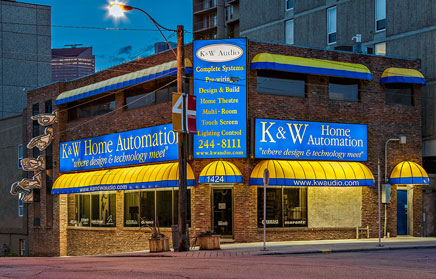TIP #19:
It seems like only yesterday, when a big screen was a 25 inch television. Today, a 25 or 29 inch TV often ends up in the bedroom. Tube televisions are now manufactured up to 37 inch with a few expensive 40 inch screens also available. Projection direct view and overhead units have been available, however they have often been lacking in several key areas (sharpness, off axis viewing, brightness, longevity, pricing and compactness).
Projection television has come a long way in the last few years, especially the direct view units. Due to recent advancements in color gun technology, high quality direct view sets are actually brighter than conventional tubes, boasting as much as 600 foot lamberts of brightness (almost twice that of many tube TVs). This means they still look very good with all the lights on.
Sharpness has improved dramatically, with up to 800 lines of resolution available (most high end tubes have 650-700 lines) thanks to velocity scan modulation (the automatic adjustment of the scan speed of the electron gun across bright/dark changes) and digital comb filters (processing the black and white separate from the color information).
A new innovation which allows the manufacturer to make bigger screens with a longer life expectancy is liquid cooling of the lenses. Due to the large size and power needed for the projection TV’s CRT electron gun, a high amount of heat is created. In the past the heat generated significantly reduced the life expectancy of the electronics and warped the lens positioning mounts, reducing the sharpness. Now the lenses are cooled just like a car’s engine, but with transparent antifreeze, resulting in constant picture quality and increased longevity.
In the past if you didn’t sit directly in front of a large screen TV the picture lacked brightness – not any more. With as much as 160 degrees of viewing field available from the best units, you can sit in any position from which a conventional tube TV would be viewed, and still get a great picture. Screen technology is mostly responsible for the increased viewing angle. Different coatings and new composites used in the actual manufacture of the screen itself allows more light through the screen at a wider angle, resulting in “tube like” performance.
Size of the cabinet (especially depth) has been a major drawback for many. In the past the long length of the projection tube, or tubes, coupled with the long focal length those tubes, sometimes resulted in a TV with a depth exceeding three feet. Thus when considering the placement of the set in a room it was necessary to take into account how much more it would jut into the room over a conventional TV.
New short focus design tubes and lens structures, combined with digital processing throughout the chassis have only very recently resulted in a shortening of the cabinets’ depth to that of an average 27″ TV (as short as 20 inches or 500 mm!). This remarkable achievement has opened up a wide range of room placement possibilities.
Many people with big screen televisions have, in the past, cut a hole in the wall and “frenched” the unit into the wall. That is still going to be popular, in that it creates a look of a picture on the wall. Some manufacturers are now introducing “monitor style” big screens not much larger, when viewed from the front, than the screen size itself. These have been designed specifically for those wishing to have their sets built into the wall. These TVs offer the slim depth, at a bit of a financial premium when comparing its price to a slim depth TV of similar size and features with the base attached. The reason for this is that the base houses most of the electronics on so equipped big screens. Compacting the electronics requires more expensive technology, and is, of course, reflected in the price.
Although much larger screen sizes are now available (up to 70″ in a direct view projection unit), pricing on these premium sets has become more affordable over the years. By way of comparison, a premium 48″ big screen five years ago was $5000, while a premium 48″ set today, with all the latest technology and obviously a better set, sells for less than $3000. This is very close to the price one would pay for a comparably featured 37″ tube TV. Given all the advancements in big screens, plus the advent of the Home Theatre surround processor, it is easy to see why their popularity is rising.
Speaking of Surround processing, big screens are available with increased audio quality and some even come with a form of DSP, or Surround Sound. While these advances do improve the sound from the set, they pale in comparison to a dedicated home audio surround processor. Almost every big screen set sold ends up mated to a home stereo, most with a surround processor. Obviously if one invests in a premium TV, then a premium surround processor becomes the logical companion.
With sound making such a difference to the Home Theatre experience, regardless of screen size, the majority of big screens sold today are added to an existing processor. Movie theatre owners must be getting very nervous.
To recap, if you are looking for a projection TV, look for foot lamberts of brightness, resolution, cooling of the lenses, screen coatings, depth and overall size parameters, a quality name, a friendly, good looking sales person, and don’t pay for audio features you will probably bypass in favor of a dedicated home audio surround processor. Happy viewing!


